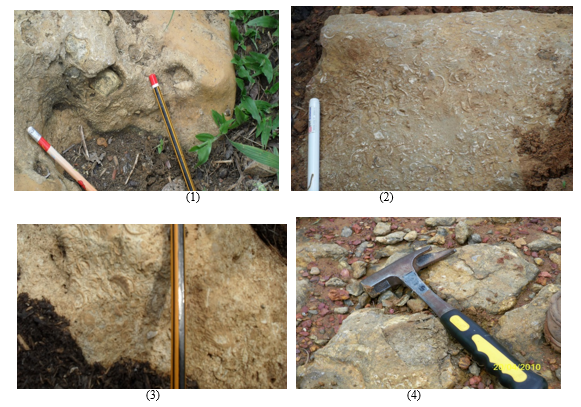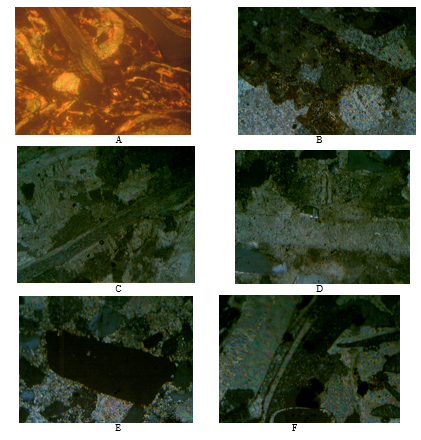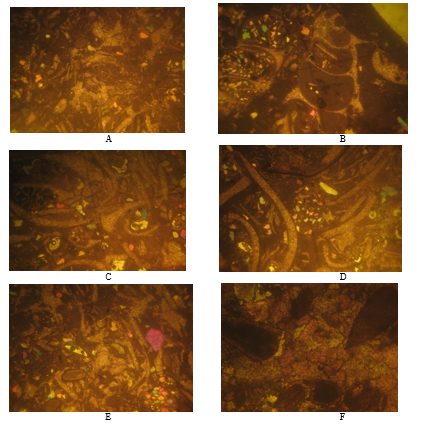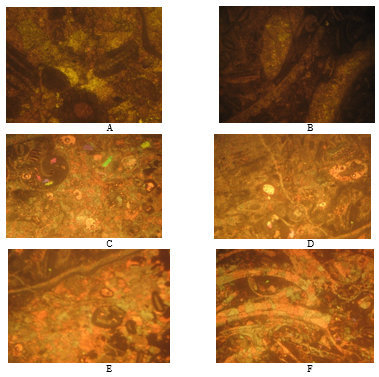Volume : 2 | Issue : 1
Technical Paper
Microfacies analysis and depositional environment of limestone deposits: Arochukwu – Obotme – Odorikpe axis southeastern Nigeria
Ideozu, R. U,1 Ikoro, D. O2 and Akpofure, E3
1Department of Geology, University of Port Harcourt, Nigeria
2Department of Geology Federal University of Technology, Owerri, Nigeria
3Department of Geology Niger Delta University, Nigeria
Received: January 09, 2019 | Published: January 14, 2019
Abstract
Microfacies analysis of limestone deposits from Arochukwu – Obotme – Odoro Ikpe Axis has been carried out complimented with biostratigraphic and sedimentological analysis. Fieldwork and Laboratory techniques employed are standard methods as used in limestone petrography (preparation of the limestone thin sections), sedimentological and biostratigraphic studies. Petrographic analysis results indicate that the limestone is made up of between 80% and 60% allochems while cements make up between 19% and 38% respectively. The allochems consists of shell fragments, whole pelecypod shells, algal grains, diatoms, foraminiferids, whole gastropods shells, bryozoans, ostracods, crinoids and coral fragments in addition to ooids/peloids, quartz grains, intraclasts and phosphate grains that make up the limestone. The cement type is interpreted as sparite and porosity type is interparticle and fracture. Important fossils identified in the limestone samples include Anomalinoides sp, Textularia sp, ostracods, pelecypods, gastropods and corals which occur either as whole skeletal forms or as fragments. Based on the microfacies characteristics, the limestone in the study area are sandy bioclastic packstone, bioclastic packstone and bioclastic wackstone - bioclastic wackstone / bioclastic packstone at Locations 5 (Amuvi), (Obotme) – 2, (Asaga) 3 and 4 (Okobo) and sandstone with about 10% shell fragments at Location 2 (Odoro Ikpe), – sandy bioclastic packstone. Two microfacies identified in the study area which correspond to SMF 5 and SMF 9. The environment of deposition is interpreted as normal marine, subtidal to shallow shelf which is consistent with shallow inner neritic to middle neritic interpreted from biostratigraphy (foraminifera and palynomorphs) identified in the limestone and associated shale samples.
Keywords: Microfacies analysis, bioclastic packstone and bioclastic wackstone
Introduction
This research focussed microfacies analysis and the depositional environment of the limestone deposits and associated sediments around Arochukwu-Obotme-Odoro Ikpe area Southeastern Nigeria. The study area Arochukwu and Environs is located within the Afikpo Basin and covers parts of Ikono and Ini Local Government Areas of Akwa Ibom State and Arochukwu Local Government Areas of Abia State - Southeastern, Nigeria. The study area is approximately 348.7 km2 and located within longitudes 7° 44’E - 8° 03’E and latitudes 5° 15 N - 5° 28’N (Figures 1 and 21). It is accessible by roads through the Ikot Ekpene – Obotme axis and Umuahia – Arochukwu axis including tracks. Benue Trough is characterized by three main sedimentary phases which include the Abakiliki – Benue phase (Aptian -Santonian), the Anambra – Benin phase (Campanian – Mid Eocene) and the Niger Delta Phase (Late Eocene - Pliocene).2–4 Majority of the sedimentary beds have been deposited in a NE – SW whereas others were deposited. The ranges of environment deposition typical of the Lower Benue Trough and within the Afikpo Basin are marine, continental, and transitional represented by the Asu River Group, Eze Aku Group, Nkporo, Mamu, Ajali, Nsukka, Imo, Ameki Formations, Nanka Sands and Benin Formation see Table 1. Ideozu,1 Ideozu and Ikoro,5 Ideozu and Solomon,6 Ideozu and Akatakpo7 and Ameh et al.8 have extensively discussed the sedimentology, stratigraphy, structural geology and petroleum geochemistry of the study area.
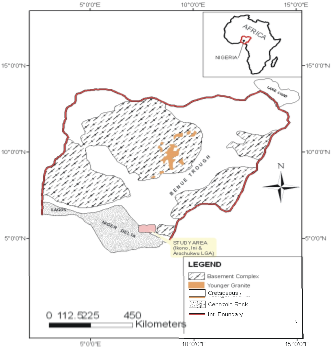
|
Figure 1 Geologic map of Nigeria indicating the study area (Inset map of Africa showing the position of Nigeria).1 |
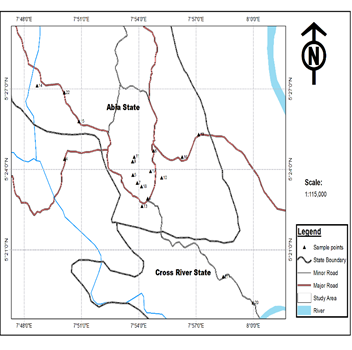
|
Figure 2 Location map of the study area (L= Sample Location).1 |
Materials and Methods
Materials
The materials used during fieldwork include compass/clinometer, GPS, measuring tapes, sample bags and sacks properly labelled, camera, protective clothing and field notebook in addition to topographic map indicating the position of the study area (Ikot Ekpene Sheet 322 on a scale of 1: 50,000).
Methods and Sample/Data Collection
Methodologies applied in this research include fieldwork and laboratory analysis. The approach used during field mapping was to document and describe the outcrops in detail in addition to methods modified from Miall,9 Tucker10 and Reijers.11 The procedures adopted for each outcrop include systematic recording of physical and biological properties of each outcrop, sketching of the outcrop including obvious features, estimating the mineralogical composition and rock type, measurement of bed thickness including strike and dip, taking note of textural features and details on fabric, preliminary field interpretation and establishing correlatable units and collection of representative samples for thin section. The outcrops identified were examined for bedding contacts, bed thickness variations, syn-sedimentary, sedimentary and biogenic structures as well as syn- and post-depositional structures. Laboratory techniques employed in the preparation of the limestone thin sections are standard methods as used in limestone petrography. The thin sections were labelled appropriately for the petrographic study. The prepared thin sections were studied under plane – and cross-polarized light to identify the constituent minerals of the framework grains in the limestone samples including their abundances. Great care was taken in the procedure adopted because identification of the minerals and framework grains depend on the subtle characteristic interference colours.12 Representative samples of limestone from the study area were trimmed and polished to the required thickness of 0.03mm, suitable for optical microscopy and photomicrographs of the thin sections were made. Limestone samples were sampled from Nsukka Formation, (forty-six (46) thin sections of limestone) from five outcrops at Odoro Ikpe (Location 1), Obotme (Location 2), Asaga (Location 3), Okobo (Location 4), Amuvi - Arochukwu (Location 5) and were prepared for petrographic studies. The spot sampling method was adopted in collecting data.13
Results
The results of this research are presented in Figures 3 – 7, Tables 2 -514,15 and Plates 1 – 7. From fieldwork five outcrops with limestone deposits were studied, the results are presented as sedimentology, biostratigraphy and lithologic description.
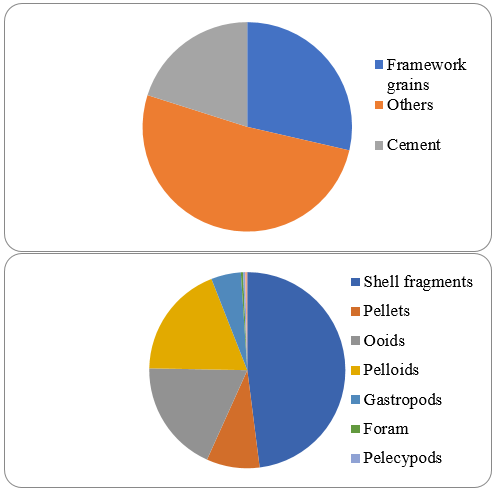
|
Figure 3 Summary of allochems, framework grains, cements and others of the limestone at Location 1 (Odoro Ikpe). |
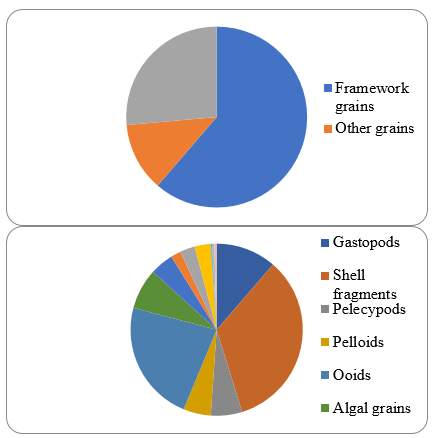
|
Figure 4 Summary of allochems, framework grains, cements and others of the limestone bed at Location 2 (Obotme). |
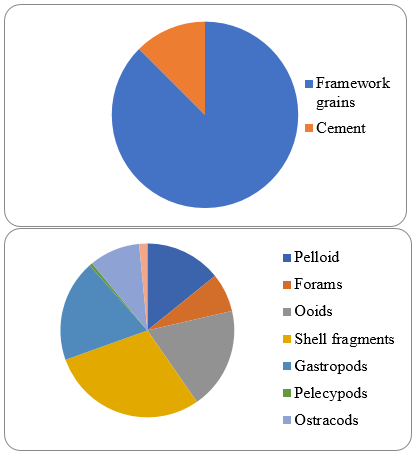
|
Figure 5 Summary of allochems, framework grains, cements and others of the limestone at Location 3 (Asaga). |
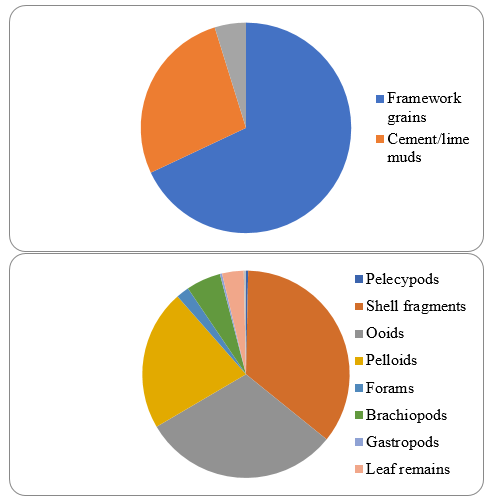
|
Figure 6 Summary of allochems, framework grains, cements and others of the limestone at Location 4 (Okobo). |
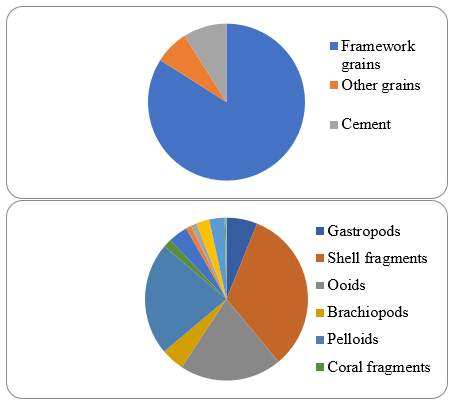
|
Figure 7 Summary of allochems, framework grains, cements and others of the limestone at Location 5 (Amuvi). |
Fieldwork
Location 1 Odoro Ikpe
Outcrop: 62.00 m: Borehole: 64.00 m: 5°30.000’N, 7°45.078’ E. Strike and dip for Nsukka Formation is 60° NE / 240° SW and Dip 14° SW while the strike for the Benin Formation is 32° NE / 212°SW dip is 4° SW. The lithostratigraphic Units are the Nsukka and Benin Formations.
Period |
Epoch |
Afikpo Basin |
|---|---|---|
Tertiary |
Pliocene-Recent |
Benin Formation |
Miocene-Mid Eocene |
Ogwashi-Asaba Formation |
|
Mid-Upper Eocene |
Ameki Formation |
|
Palaeocene |
Imo Shale |
|
Cretaceous |
Maastrichtian |
Nsukka Formation |
Campanian |
Nkporo Shale |
|
Santonian/ Coniacian |
Agwu Formation |
|
Turonian |
Eze-Aku Formation |
|
Albian |
Asu River Group |
Table 1 Lithostratigraphic units in Afikpo Basin Area after Oboh- Ikuenobe et al.16
SKELETAL GRAINS/ |
L1S1 |
L1S2 |
L1S3 |
L1S4 |
L1S5 |
L1S6 |
L1S7 |
|---|---|---|---|---|---|---|---|
Ostracods |
- |
- |
- |
- |
- |
- |
- |
Brachiopod |
- |
- |
- |
- |
- |
- |
- |
Pelecypod |
- |
- |
- |
- |
- |
- |
- |
Gastropod |
R |
- |
- |
F |
- |
- |
- |
Others |
R |
- |
- |
R |
R |
- |
- |
Skeletal Fragments |
F |
R |
R |
A |
R |
F |
R |
Peloids/Ooids |
C |
C |
C |
A |
A |
R |
R |
Intraclasts |
- |
- |
- |
- |
- |
- |
- |
Terrigenous Particles |
A |
A |
A |
C |
A |
A |
A |
Micrite |
- |
- |
- |
R |
- |
- |
- |
Sparite |
R |
R |
R |
A |
R |
R |
- |
Calcite |
A |
A |
A |
A |
A |
A |
A |
Silica |
C |
C |
C |
C |
C |
C |
C |
Haematite |
A |
A |
C |
A |
A |
C |
C |
Porosity Type |
|||||||
Fracture |
- |
- |
- |
- |
- |
- |
- |
Interparticle |
A |
A |
A |
A |
A |
A |
A |
Intraparticle |
F |
F |
F |
A |
A |
A |
C |
Mouldic |
- |
- |
- |
- |
- |
- |
- |
Legend: R= 0.1 – 5%, F= 6 – 10%, C=11 – 15%, M=16 – 20%, A=21% and above.
Table 2 Microfacies characteristics of limestone at Location 1 (After Wilson 1980 a, b)
SKELETAL GRAINS/ |
L2S1a1 |
L2S1a2 |
|
|
L2S1b |
L2S2 |
L2S3 |
L2S4 |
|---|---|---|---|---|---|---|---|---|
Ostracods |
R |
R |
|
|
R |
R |
NIL |
NIL |
Brachiopod |
F |
C |
|
|
F |
R |
NIL |
R |
Pelecypod |
R |
NIL |
|
|
R |
R |
R |
NIL |
Bryozoans |
NIL |
R |
|
|
R |
R |
NIL |
NIL |
Gastropod |
R |
R |
|
|
R |
R |
NIL |
R |
Others |
C |
C |
|
|
C |
R |
F |
C |
Skeletal Fragments |
C |
A |
|
|
M |
A |
A |
A |
Peloids/Ooids |
C |
F |
|
|
C |
A |
C |
A |
Intraclasts |
R |
Nil |
|
|
Nil |
R |
R |
C |
Terrigenous Particles |
F |
R |
|
|
R |
F |
F |
F |
Micrite |
C |
C |
|
|
C |
C |
C |
C |
Microsparite |
C |
C |
|
|
C |
C |
C |
C |
Calcite |
A |
A |
|
|
A |
A |
A |
A |
Silica |
R |
R |
|
|
R |
F |
F |
F |
Haematite |
R |
A |
|
|
A |
R |
R |
R |
Porosity Type |
|
|
|
|||||
Fracture |
R |
R |
|
|
R |
Nil |
Nil |
Nil |
Interparticle |
C |
C |
|
|
C |
C |
C |
C |
Table 3 Microfacies characteristic of limestone at Location 2 (After Wilson 1980 a, b)
SKELETAL GRAINS/ |
AS1 |
AS 2 |
AS 3 |
AS 4 |
AS 5 |
AS 6 |
|---|---|---|---|---|---|---|
Ostracods |
R |
R |
F |
R |
F |
R |
Brachiopod |
R |
R |
- |
- |
- |
- |
Pelecypod |
R |
R |
R |
- |
- |
- |
Gastropod |
R |
R |
R |
F |
C |
A |
Others |
R |
R |
R |
R |
R |
F |
Other allochems |
||||||
Skeletal Fragments |
A |
R |
A |
A |
A |
A |
Peloids/Ooids |
A |
A |
F |
A |
A |
F |
Intraclasts |
- |
- |
- |
- |
- |
- |
Terrigenous Particles |
R |
R |
R |
R |
R |
R |
Cement |
||||||
Micrite |
A |
A |
A |
A |
A |
A |
Microsparite |
A |
A |
A |
C |
A |
A |
Diagenetic Minerals |
||||||
Calcite |
A |
A |
A |
A |
A |
M |
Silica |
R |
R |
C |
C |
C |
R |
Hematite |
C |
C |
C |
C |
C |
C |
Porosity Type |
|
|||||
Fracture |
- |
- |
- |
- |
- |
- |
Interparticle |
A |
A |
A |
A |
A |
A |
Intraparticle |
A |
A |
A |
A |
A |
A |
Mouldic |
R |
C |
C |
C |
C |
C |
Table 4 Microfacies characteristics of limestone at Asaga -location 3 (After Wilson 1980 a,)
SKELETAL GRAINS/ |
L4S1 |
L4S2 |
L4S3 |
L4S4 |
L4S5 |
L4S6 |
L4S7 |
|---|---|---|---|---|---|---|---|
Ostracods |
- |
- |
- |
C |
- |
C |
C |
Brachiopod |
- |
- |
- |
- |
R |
- |
- |
Pelecypod |
- |
- |
- |
- |
- |
R |
R |
Gastropod |
- |
R |
- |
- |
R |
C |
C |
Others |
R |
R |
F |
R |
R |
- |
- |
Skeletal Fragments |
A |
A |
R |
A |
A |
A |
A |
Peloids/Ooids |
A |
A |
R |
A |
A |
C |
R |
Intraclasts |
R |
- |
R |
- |
R |
- |
- |
Terrigenous Particles |
R |
R |
C |
C |
R |
- |
R |
Micrite |
C |
C |
C |
C |
C |
C |
C |
Sparite |
A |
A |
A |
A |
A |
C |
A |
Calcite |
C |
A |
R |
A |
A |
A |
A |
Silica |
R |
R |
C |
C |
R |
A |
A |
Hematite |
R |
R |
C |
C |
C |
A |
A |
Porosity Type |
|||||||
Fracture |
R |
A |
A |
R |
A |
R |
R |
Interparticle |
A |
A |
C |
A |
A |
A |
C |
Intraparticle |
R |
A |
A |
A |
A |
A |
C |
Mouldic |
A |
R |
R |
R |
R |
R |
R |
Table 5 Microfacies characteristics of limestone at location 4 (After Wilson 1980 a, b)
Sedimentology
The lithostratigraphic units at this location is the Nsukka and Benin Formations - observed in both outcrop and borehole drilled 500 m from the outcrop. From field relations, the Nsukka Formation is unconformably overlain by the Benin Formation and an unconformity was established based on high dip values and biostratigraphy.1 The borehole penetrated all the beds in the outcrop – Nsukka and Benin Formations. The Nsukka Formation is 4.92m made up of shale and limestone (0.91 – 3.40 m) having sharp to gradational contacts. The shale is grey to greenish, massive and fractured in outcrop, in the borehole the shale is grey. Whereas the limestone, is whitish to brownish, and mainly composed of lime mud and sand fractions. The Benin Formation is 53.73 m comprising a sequence of pebble, sand and clay beds ranging from 0.10 – 12.33 m. The bedding contacts is gradational to erosional with pebble lags. The Benin Formation is friable, poor to very poorly sorted, angular to well-rounded especially the pebbles, whitish to reddish with sedimentary structures such as planar crossbeds and biogenic structures indicating influence of the marine. The pebble beds are, friable, round to very well rounded, poorly to very poorly sorted and matrix supported (comprising mainly clay, sand and silts), muscovite flakes are common especially in the clayey matrix. The sandy beds are fine to coarse grained sands – clay clasts are common, clayey, and friable and poorly to very well- sorted. Iron stone fragments are common; in addition, the sandy beds are whitish to brownish. The clayey beds have thicknesses, ranging from 0.10 – 0.90 m. They are whitish with reddish patches, mottled with bedding contacts - sharp to erosional.
Biofacies Description
The clay beds of the Benin Formation have yielded no diagnostic palynomorphs and foraminifera, they are mostly barren but reworked palynomorphs are observed. The Nsukka Formation at this location, is fossiliferous with diagnostic forms (Foraminifera and palynomorphs). Gastropods, pelecypods and ostracods as observed this justifies the shallow marine environment interpreted for the shale and limestone beds. The association of Proxapertites operculatus, Mauritidites crassibaculatus, and M. crassiexinous, and the association of Lenticulina midwayensis, Cibicides succedens,17 C. harperi, Planulina nacatochensis Anomalinoides unboniferous, and A. midwayensis in addition to Gavelinella guineana,18 Valvulineria aegyptica,19 Morozovella aequa, M. acuta,20 and Eponides elevatus date this bed as Late Maastrichtian to Palaeocene and the environment of deposition is interpreted as middle neritic.
Location 2 Obotme
Outcrop: 48.5m: 5° 24.381’ N, 7° 50.123’ E: Strike: 76° NE / 272° SW Dip 4°-6°. The lithostratigraphic units are the Mamu, Ajali and Nsukka Formations.
Sedimentology
Lithostratigraphic units at this location is the Mamu, Ajali and Nsukka Formation. The Mamu Formation is 4.0 m thick made up of only shale. It is grey to dark grey, finely laminated, massive and hard. When split breaks along conchoidal fractures, trace fossils and faecal pellets are rare. Sedimentologically, it is composed of sub-angular to rounded quartz grains 60%, rock fragments 10%, pyrites 10%, coal fragments 3%, muscovite flakes 10% and fossils 3%. Age diagnostic taxa were recovered for both foraminifera and palynomorphs. The Ajali Formation is 14.6 m thick covered with flora; the exposed section showed the Ajali Formation as very fine, lateritic and reddish to brownish. The lithologic boundary between the Mamu and Ajali Formation is sharp, in addition a spring was observed at this contact. The Nsukka Formation is 29.46 m comprising shale and limestone occurring as lenses. The shale is grey to black, fissile and very fossiliferous. Sedimentological analysis shows that the shale comprises 38.2 % quartz grains, 16.0 % rock fragments, 3.6 % faecal pellets, 12.4 % coal fragments, 3.4 % muscovite flakes, 20.0 % pyrite, 2.4 % rootlets, 1.8 % glauconite, 1.0 % gastropods and fossil content 2.2 %. Diagnostic foraminifera and palynomorphs were recovered. Limestone occurs in the Nsukka Formation as two lenses 0.24 m and 2.10 m respectively. The limestone is bioclastic with abundant bivalves, gastropod, ostracods and shell fragments and whitish to greyish towards the base where it has contact with shale.
Biofacies Description
The Mamu Formation has the following recovered foraminifera Haplophragmoides saheliense, H. excavata,21 Lagena semiornata, Textularia laevis, Spiroloculina badness, Heterohelix striata, Siphongeneriniodes sp, Globorotalia haynesi, Planularia toddae, Globorotruncana linneiana, Bulimina trigonalis, Lenticulina midwayensis, and Cibicides succedens. While palynomorphs recovered include Proxapertites operculatus, Psiladiporites nnewiensis, Retricolporites crassireticulatus, Mauritidites crassiexinous, Syncolporites sp, Syncolporites marginatus, Wietzeiela sp, Milfordia Jardinei, Retidiporites magdalenensis, Homotryblium sp, Spiniferites bifurcates, Fybrocysta sp, Lingolodinium sp, Longapertites sp, Longapertites marginatus, Apectodinium sp, Ephedriporites sp, Lygodiumsporites adrennis, Foveotriletes margaritae, Nematosphaeridium sp, Retidiporites adegokei, Homotryblium constructum, Laevigatosporites discordatus, and Rugulatisporites caperatus. The following foraminifera assemblages; Globorotalia hayensi, Globotruncana linneriana and Heterohelix striata (planktonic forms) age diagnostic; whereas the following foraminifera; Lagena semiornata, Textularia laevis, Spiroloculina badenesis, Siphongenerimodes sp, Haplophragmoides Saheliense, H. excavata,21 Planularia toddae, Lenticulina midwayensis, Cibicides succedens and Bulimina trigonalis are benthonic forms. The palynomorphs recovered include, Proxapertites operculatus, Retricolporites crassireticulatus, Mauritidites crassiexinous, Retidiporites adegoke and, Homotryblium constructum. The formation is dated Late Campanian - Maastrichtian and the environment of deposition is interpreted as shallow inner to inner neritic? The Nsukka Formation is dated Late Maastrichtian - Paleocene based on the association of the following palynomorphs and foraminifera Nonionella Insecta, N. cummunis, Fursenkoina wilcoxensis, F. nigeriana, Lenticulina midwayensis, Cibicides succedens, Anomalinoides unboniferous, A. midwayensis, Elphidiella africana, Gavelinella guineana, A. midwayensis, Mauritidites crassibaculatus, M. crassiexinous, M. crassibaculatus Apectodinium sp, Triporollenites sp, Proxapertites operculatus and Spiniferites hyalosoinous whereas the environment of deposition ranges from inner neritic to outer neritic. The limestone occurring as lenses is also dated as Late Maastrichtian to Paleocene based on the following associations of forams: Anomalinoides unboniferous, and A. midwayensis, Lenticulina midwayensis, Quinculoculina sp, Planulina nacatochensis, and Eponides elevatus. The environment of deposition is interpreted as shallow inner neritic.
Location 3 Asaga - Arochukwu
Outcrop: 1.2 m Borehole – water well: 12 m 5° 24.465’ N,7° 53.765’ E Shrike: 331°NW / 151°SE
Lithostratigraphic Unit: Nsukka Formation
Lithologic Description
Depth (m) Lithologic Description
1.2 Limestone made of lime mud and shell fragments, whole gastropod, pelecypod and bivals. It is fossiliferous and whitish to brownish.
13.2 Shale, greyish to black and fissile.
Sedimentology
The Nsukka Formation consists of two lithology - shale and limestone at this outcrop. The limestone occurs as a lens within the shale but have now been exposed on the surface by erosion and scattered as boulders. In addition, some of the boulder – limestone have been affected by chemical weathering. Thickness of the boulders ranges from 0.24 – 1.2 m, whitish to brownish. The limestone is fossiliferous with abundant whole gastropods, pelecypods, bivals and shell fragments. It is bioclastic and has lime mud. The shale is fissile, grey to black. The lithologic boundary is sharp to gradational. See Plates 1-2.
Biofacies Description
Shale and limestone lithology make up the lithologic units of the Nsukka Formation. Only palynomorphs date the shale unit whereas the foraminifera are not age diagnostic. The shale unit is dated Maastrichtian to Palaeocene based on the association of the following palynomorphs Longerpertites marginatus, L. microfoveolatus, Paleocystodinium sp, Proxapertites operculatus, P. cursus, Spectotetradites varireticulata, Selenopemphix sp, Milfordia jadenei, Cyathidites minor, Monocolpopollenites sohaeroidites, Leitroites adrennis, Circulina parva, Mauritidites crassiexinous, M. crassibaculatus, Lingolodinium sp, Gleicheniidites senonicus, Zonosulcites parvus, Retitricolpites magdalennensis, Ifecysta pachyderma, Spiniferites hyalospinosus, Tricolpopellenites sp, Psilatriporites sp, Echitriporites trianguliformis, Proteacidites longispinosis, Retidiporites sp, Numulipolis sp, Lejenacysta sp, Cycadopites sp and Andalusiella sp. The following benthonic foraminifera were recovered from the limestone unit and include Marginulina dorsata, Textularia hackeyensis, Haplophragmoides talokaense, H. nigeriense and H. sahariense. In addition, the following foramifera were identified Epistomina faux, Textularia sp and Cibicides sp based on thin section studies and the environment of deposition is interpreted as shallow inner neritic.
Location 4 Okobo
5° 27.110’N, 7° 48.685’ E, 292°NW 102° SE, Dip: 4 - 6° SW, Lithologic Unit: Nsukka Formation.
Lithologic Description
Depth (m) Lithologic Description
5.20 Clay reddish to brownish.
7.40 Shale greyish with calcareous sand lenses, skolithos is observed.
21.11 Shale brownish to greyish.
25.38 Limestone, bioclastic grey to whitish with abundant bivalves and gastropod shells.
36.66 Shale, grey to black, fissile with joints and joint sets in all directions. Water from the underlying bed rises to the surface indicating that the bed below is a sandy bed probably Ajali Formation that has been charged with water, issuing out as spring.
Sedimentology
The Nsukka Formation at this outcrop comprises clays, interbedded shale and calcareous reddish sand, whitish to greyish bioclastic limestone and thick grey to black shale. The shale is grey to black, fissile, fossiliferous and fractured. Water flows out through this cracks or fractures indicating that, there is reservoir sand below, probably the Ajali Formation. The limestone is bioclastic with abundant shell fragments, whole gastropod, pelecypod and bivals. The sand lenses within the shale is reddish and calcareous.
Biofacies Description
The outcrop has yielded mainly benthonic foraminifera such as Bolivina midwayensis, B. crassicostata, Cibicides sp and gastropods. These forms suggest a Maastrichtian – Palaeocene age and a shallow – inner neritic environment of deposition. The palynological content of the shale is not age diagnostic, these are Monocolpopollenites sphaerodites, Monocolpites marginatus and Leiotriletes adrennis. From petrographic analysis of the limestone the following forms was identified Cibicides sp, Anomalinoides midwayensis and Epistomina faux. These forms indicate a Maastrichtian – Palaeocene age for the outcrop -Nsukka Formation
Location 5 Amuvi- Arochukwu, Outcrop
5° 25’.792 N / 7° 50.866 E, 62° NE / 159° SW dip 20°.SE, Lithologic unit. Nsukka Formation.
Sedimentology
The limestone in this outcrop occurs along the Amuvi – Okobo road, the thickness ranges from 10cm to 24cm and rests directly on the shale (Figure 4). The limestone beds Lithologic contact: Limestone / shale. This limestone lenses of the Nsukka Formation outcrops along Okobo road, the thickness ranges from 10cm to 24cm and rests directly on the shale. It is bioclastic with abundant shell fragments greyish to reddish.
Biofacies Description
Foraminifera identified from thin section studies include Valvulinera jacksonensis, Textularia sp, Nonionella cummunis and Eponides psuedoelevatus and gastropod shells. These forms suggest a Maastrichtian to Palaeocene for the limestone and the environment of deposition is interpreted as shallow marine.
Petrographic Analysis results
The results of the petrographic analysis of the limestone samples presented Figures 3 – 7, Tables 2 – 5 and Plates 5 -7. The limestone from the study area, have the following characteristics:
- Microfractures - observed in majority of the slides studied especially on the shell fragments.
- Gastropods, pelecypods, ostracods, foraminiferids and shell fragments are abundant in all samples analysed
- 90% of the ooids and peloids deformed.
- Some of the peloids, ooids and shell fragments have been replaced by sparite or are micritic.
- Cements are sparite, micrite, calcite, haematite, silica or dolomite?
- Most of the textural details in the samples analysed have been obliterated either through diagenesis or by coarse replacement of dolomite.
Microfacies Analysis
Microfacies of the limestone deposit in the study area, have been identified by the study of thin sections and involve the determination of the composition and textures of the limestone. Microfacies analysis is the aggregate of all the sedimentological and biostratigraphic criteria. Differentiation of microfacies (MF) types form an essential part of facies analysis. Two microfacies – Packstone and Wackstone have been interpreted for the study area.
Packstone Microfacies
The packstone microfacies consist of more than 50% of the grains, in a micritic matrix.22 It comprises various grains as its components such as skeletal fragments, peloids and ooids. The packstone microfacies in the study area are sandy bioclastic packstone (Location 1) and bioclastic packstone (Locations 3 -5).
Location 1
Sandy Bioclastic Packstone Microfacies
These facies comprise skeletal fragments, peloids, gastropods and abundant sand grains in a micritic matrix. Diagenetic minerals include calcite, silica and hematite. The porosity type is mainly interparticle and intraparticle. See Table 2, Plates 5 and Figure 3.
Location 3
Bioclastic Packstone Microfacies
These facies comprise the following bioclasts; Abundant skeletal fragments, ostracods, brachiopods, pelecypods, abundant peloids and ooids, lime mud has very low percentage. Cement type is mainly micritic, diagenetic minerals are calcite, silica and hematite. Porosity type is mouldic, intraparticle and interparticle. See Table 4, Plates 3 – 5 and Figure 5.
Locations 4 and 5
Bioclastic Packstone Microfacies
The microfacies in locations 4 and 5 comprises abundant skeletal fragments, ooids and peloids, gastropods, pelecypods, brachiopods and sand grains. Cement type is mainly sparite, diagenetic minerals include calcite, hematite and silica. Porosity type is interparticle and intraparticle. See Table 5, Plates 3 -5 and Figures 6 -7.
Wackstone Microfacies
The wackstone microfacies is a carbonate microfacies with more than 10% allochems / grains embedded in a micritic matrix.22 The faunal assemblage present in this microfacies consists of gastropods, pelecypods and brachiopods. Location 2 is interpreted as bioclastic wackstone.
Location 2
Bioclastic Wackstone Microfacies
These facies are made up of ostracods, pelecypods, gastropods and shell fragments, leaf fragments, ooids, peloids and intraclasts. Lime mud is very abundant, cement is mainly micritic. Diagenetic minerals include calcite, silica and hematite. Porosity type is mainly intraparticle and fracture. See Table 3, Plates 6 and Figure 4.
Microfacies Description
The microfacies in the study area has been compared with the Standard Microfacies (SMFs) of Wilson23 and Flugel.24 Two SMFs identified in the study area, SMFs 5 (sandy bioclastic packstone, bioclastic packstone) and SMFs 9 (bioclastic wackstone).
Standard Microfacies 5
The bioclastic packstone facieses composed of skeletal fragments which demonstrated faunal diversity, these include whole shells and fragments of pelecypods, brachiopods and ostracods. The non-skeletal fragments comprise ooids, peloids and intraclasts. These facies are deposited in a normal marine, subtidal to shallow shelf environments.25
Standard Microfacies 9
The bioclastic wackstone facies is composed of skeletal fragments which shows faunal diversity.
Discussion
Petrographic analysis results indicate that the limestone is made up of between 80% and 60% allochems whereas cements make up between 19% and 38% respectively. The limestone is interpreted as bioclastic for the study area based on Dunham’s classification scheme.22 The allochems consists of shell fragments, whole pelecypod shells, algal grains, diatoms, foraminiferids, whole gastropods shells, bryozoans, ostracods, crinoids and coral fragments in addition to ooids/peloids, quartz grains, intraclasts and phosphate grains that make up the composition of the limestone (see Plates 5 - 7). The cement type is interpreted as sparite and porosity type is interparticle and fracture. Important fossils identified in the limestone samples which make up the limestone beds include Anomalinoides sp, Textularia sp, ostracods, pelecypods, gastropods and corals. These fossils occur either as whole skeletal forms or as fragments. Based on a chart of common lithofacies symbols used in describing carbonate reservoirs and associated rock types two microfacies have been identified. See Tables 2 – 5. The limestone types correspond to SMF 5 and SMF 9.22,26–29 The environment of deposition is interpreted as normal marine, subtidal to shallow shelf. The interpreted environment of deposition is consistent with shallow inner neritic to middle neritic interpreted from biostratigraphy based on foraminifera and palynomorphs identified in the limestone and shale samples from the study area.1 The limestones in the study have varying compositions - bioclastic wackstone / bioclastic packstone at Locations 5 (Amuvi), (Obotme) – 2, (Asaga) 3 and 4 (Okobo) and sandstone with about 10% shell fragments at Location 2 (Odoro Ikpe), – sandy bioclastic packstone. Based on the microfacies characteristics, the limestone in the study area are sandy bioclastic packstone, bioclastic packstone and bioclastic wackstone. Based on Dunham’s classification, they are classified as bioclastic packstone and bioclastic wackstone microfacies (Figures 3 – 7, Plates 5 -7 and Tables 3 – 7).22 Gastropods, pelecypods, foraminifera, ostracods and algae constitute the major bioclasts while pellets and lithoclasts are the minor non-bioclastic components of the limestone such as ooids, peloids and intraclasts.14,15,30 The presence of ostracods, gastropods, pelecypods, coral fragments and leaf fragments strongly supports a shallow marine for the limestone and associated shales in the area combined with biostratigraphy.1
Conclusion
The results of this research based on data generated from field and petrographic studies, indicates that the limestone beds where deposited in a shallow marine environment. The limestones in the study area are mostly bioclastic with abundant bi-valve shells, gastropods, pelecypods and shell fragments. Based on Dunham’s classification, they are classified as bioclastic packstone and bioclastic wackstone and correspond to standard microfacies 5 and 9.22
References
- Ideozu R. Sedimentology of Post - Santonian Sediments in Parts of Afikpo Basin Southeastern Nigeria (Unpublished PhD Dissertation). 2014.
- Short K, Stauble A. Outline of the Geology of Niger Delta. Am Assoc Pet Geol Bull. 1967;51(5):761-779.
- Murat R. Stratigraphy and Paleogeography of the Cretaceous and Lower Tertiary in Southern Nigeria. In: Proceedings. Ed. by T.F.J. Dessauvagie and A.J. Whiteman. Ibadan, Nigeria, Dept. of Geology University of Ibadan; 1972:251-266.
- Obi G, Okogbue C, Nwajide C. Evolution of Enugu Cuesta: A Tectonically Driven Erosional Processes. Glob J Pure Appl Sci. 2001;7:321-330.
- Ideozu R, Ikoro D. Sedimentology of Conglomeratic Beds within Odoro Ikpe –Arochukwu Axis: Afikpo Basin Southeastern Nigeria. Int J Min Geol. 2015;5(2):1-15.
- Ideozu R, Solomon E. Sedimentology of Ajali and Benin Formations in Arochukwu – Odoro Ikpe Axes Southeast Nigeria. Sci Afr Int J Pure Appl Sci. 2017;16(2):291-313.
- Ideozu R, Akatakpo C. Evaluation of Paleoenvironment Using Quartzite Clasts in Odoro Ikpe Area Southeastern Nigeria. J Appl Geol Geophys IOSR-JAGG. 2018;6(4):47-55.
- Ameh C, Aina O, Ogbuwa K, Abrakasa S, Ideozu R. Source Rock Geochemistry of the Nsukka Formation in Arochukwu Area of Afikpo Basin, South‒Eastern Nigeria. IOSR J Appl Geol Geophys. 2016;4(5):24-28.
- Miall A. Principles of Sedimentary Basin Analysis. Berlin: Springer-Verlag; 1984.
- Tucker M. Sedimentary Petrology. 2nd ed. Oxford: Blackwell Science Limited; 1988.
- Reijers T. Selected Chapters in Geology. Warri, Nigeria: Shell Petroleum Development Company; 1996.
- Curry A, Grayson R, Horsey G. Under the Microscope. Poole: Blandford Press; 1982.
- Davis JC. Statistics and Data Analysis in Geology. New York: John Wiley & Sons Inc; 1973.
- Wilson J. Limestone and Dolomite Reservoirs. In: GD Hobson, Ed., Developments in Petroleum Geology. Vol 2. Essex, UK: Applied Science; 1980:1-52.
- Wilson J. A review of Carbonate Reservoirs. In: AD Miall, Ed., Facts and Principles of World Petroleum Occurrence. Canadian Society of Petroleum Geologists Memoir 6. ; 1980:95-115.
- Oboh-Ikuenobe F, Chucks G, Jaramillo C. Lithostratigraphic Units of Anambra basin. Correlation Chart Cretaceous Tertiary Strata in Southern Nigeria. J Afr Earth Sci. 2005;41:101-112.
- Brotzen F. The Swedish Paleocene and Its Foraminiferal Fauna. Stockholm: Norstedt; 1948.
- Petters S, Adegoke O. Excursion to the Shagamu Quarry (Paleocene – Eocene). In: In Adegoke, O. S (Ed); Geological Guide to Some Nigerian Cretaceous – Recent Localities. Vol 2. Nigerian Mining Geoscience Special Publication; 1980:1-26.
- Le Roy L. Biostratigraphy of the Magfi Section, Egypt. Geol Soc Am. 1953;54:1.
- Toulmin L. Eocene, Smaller Foraminifer from the Salt Mountain Limestone of Alabama. J Palaeontol. 1941;15:567-611.
- Petters S. Paralic Arenaceous Foraminifera from the Upper Cretaceous of the Benue Trough, Nigeria. Palaeontol Pol. 1979;24(4):451-471.
- Dunham RJ. Classification of Carbonate Rocks According to Depositional Textures. 1962;38:108-121.
- Wilson J. Carbonate Facies in Geologic History. New York: Springer-Verlag; 1975. //www.springer.com/gp/book/9780387903439. Accessed January 16, 2019.
- Flügel E. Microfacies Analysis of Limestones. Berlin Heidelberg: Springer-Verlag; 1982. //www.springer.com/gp/book/9783642684258. Accessed January 16, 2019.
- Ekwere S, Esu E, Okereke C, Akpan E. Evaluation of Limestone in Obotme Area (Southeastern Nigeria) for Portland Cement Manufacture. J Min Geol. 1994;30:145-150.
- Choquette PW, Pray LC. Geologic Nomenclature and Classification of Porosity in Sedimentary Carbonates. AAPG Bull. 1970;54(2):207-250.
- Swanson R. Methods in Exploration Series. In: Sample Examination Manual. American Association of Petroleum Geologist; 1981:103.
- Wilson J, Jordan C. Middle shelf. In: PA Scholle, DG Bebout and CJ Moore, Ed. Carbonate Depositional Environments. American Association of Petroleum Geologist Memoir 33. ; 1983:298-343.
- Embry A, Klovan J. A Late Devonian Reef Tract on NW Banks, Northwest Territories. Can Pet Geol Bull. 1971;19:730-781.
- Akaegbobi IM, Ogungbesan GO, Ogala JE. Carbonate microfacies and major element content of the Paleocene – Eocene sections exposed at the Sagamu quarry, eastern Dahomey basin, Nigeria. Glob J Geol Sci. 2011;9(2):241-251-251.
